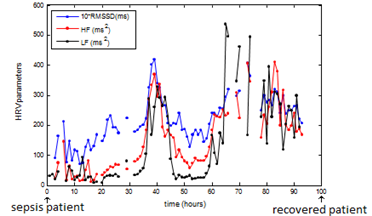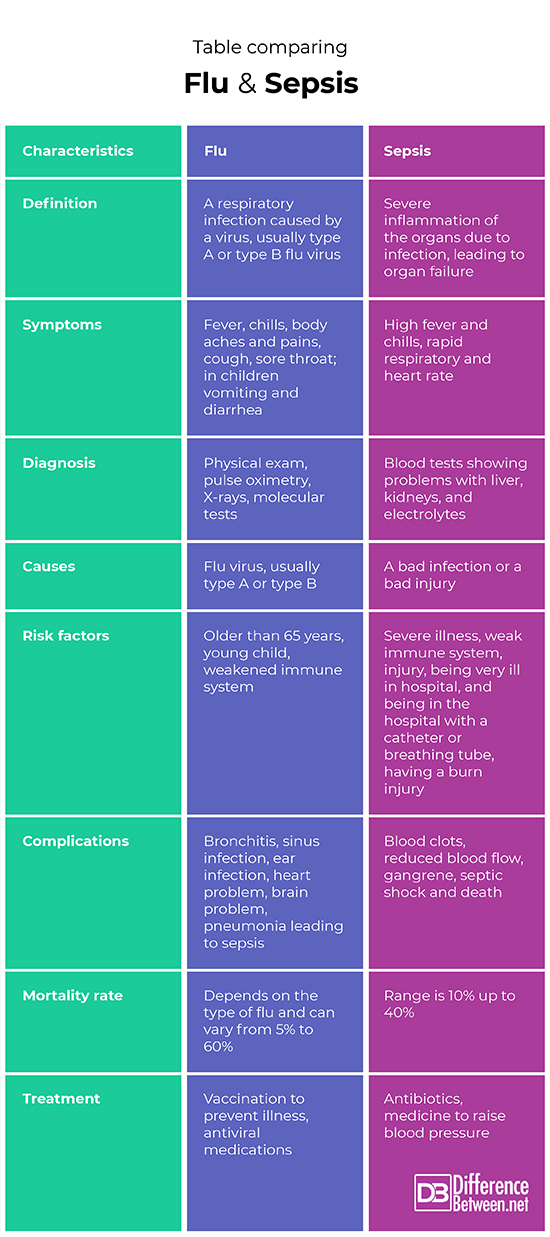Difference Between Flu and Sepsis
What is Flu?
Definition of Flu
The flu is also known as influenza and is an upper respiratory infection that is caused by a virus that can occur in different types. Type A and type B influenza viruses cause most illnesses. The flu does cause people to die each year due to complications. Recent mortality rates can be as high as 5% for the usual seasonal strains and types of flu, to as high as 60% for bird flu.
Flu Symptoms
Symptoms include a fever, chills, a cough, and often also pains and aches all over the body. Usually, there is also a headache, sore throat and weakness and sweating. Children may also experience vomiting and diarrhea along with the previous symptoms.
Diagnosis and causes for Flu
The flu is diagnosed with a physical exam, pulse oximetry, and chest X-rays. Molecular tests such as RT-PCR can definitively diagnose the strain of flu that is present. The flu is caused by a virus that is usually type A or type B. The exact type of flu virus changes each year.
Risk factors and complications
Certain people are at a higher risk of getting the flu. Usually, people older than 65, young children and people with weakened immune systems have a higher risk. However, this can vary with the strain of flu. Several complications can occur with the flu. Common complications include pneumonia, bronchitis, sinus infections, and ear infections. There is also a chance that the infection can cause heart and brain problems. Some of these complications such as pneumonia can lead to sepsis and possibly death.
Treatment for Flu
The best option is vaccination as this usually provides good protection from the flu. A vaccine can either prevent you from becoming ill or lessen the severity of the illness. There are antiviral drugs that can be given to reduce the severity of the illness. These work if given quickly. Vaccination is still the most recommended way to prevent the flu.
What is Sepsis?
Definition of Sepsis:
Sepsis is the inflammatory response to some type of infection that is present in the body. In sepsis, chemicals are produced that can cause organ damage. Sepsis has quite a high risk of death with mortality varying from about 10% to as much as 40%.
Sepsis Symptoms:
Sepsis includes symptoms such as a fever that is high and above 101oF. A person can also have chills because the temperature of the body can drop to lower than 96.8oF. There is also a fast respiratory rate and heart rate (more than 90 beats every minute).
Diagnosis and causes:
Diagnosis is made by blood tests that indicate that there are a massive infection and inflammation throughout the body. Signs of infection include problems with the body’s electrolytes and the presence of substances in the blood that show kidney and liver problems and blood clotting problems. Sepsis is most often caused by severe infections in the abdomen including kidney problems. Blood infections and pneumonia can also lead to sepsis.
Risk factors and complications:
Risk factors for sepsis include being elderly or very young, being very ill in the hospital and having a weakened immune system, also having a very bad injury such as a burn to the body. The presence of invasive medical devices such as indwelling catheters or breathing tubes also makes you susceptible to sepsis. Complications include reduced blood flow, clots, gangrene, and death.
Treatment for Sepsis:
Sepsis is usually treated using powerful intravenous general antibiotics and sometimes medication to increase the blood pressure.
Difference between Flu and Sepsis?
-
Definition
The flu is a viral infection that affects the respiratory tract. Sepsis is a type of severe inflammatory response of the body to a massive infection.
-
Symptoms
Flu symptoms include a fever, chills, cough, sore throat, headache, aches and pains, and in children, vomiting, and diarrhea. Sepsis symptoms include a high fever, chills, increased respiratory and heart rate, low blood pressure, nausea, confusion and reduced urination.
-
Diagnosis
The flu is diagnosed by a physical exam, chest X-ray, pulse oximetry, and molecular tests. Sepsis is diagnosed using blood tests that show signs showing infection such as abnormal results for the liver, kidney, and electrolytes.
-
Causes
The flu is caused by a virus that is usually of type A or type B. Sepsis is caused by an injury or an infection that is very severe.
-
Risk factors
Risk factors for getting the flu include being over 65, being a young child, having a weakened immune system. Risk factors for sepsis include having a severe illness and being sick in a hospital.
-
Complications
The flu can cause complications such as bronchitis, sinus infections, ear infections, heart and brain infections, and pneumonia. Pneumonia can lead to sepsis. Sepsis complications include blood clots, gangrene, and possibly death due to septic shock.
-
Mortality rate
The mortality rate for the flu varies according to strain and can be from 5% to 60% (bird flu). The mortality rate of sepsis can range from 10% to 40%.
-
Treatment
The best option for the flu is vaccination to avoid becoming ill or to lessen illness. The other option is to treat with antiviral medications. Sepsis can be best treated with general antibiotics and medicine to raise the blood pressure if needed.
Table comparing Flu and Sepsis
Summary of Flu Vs. Sepsis
- Flu is a viral infection that can lead to sepsis
- Sepsis is a massive inflammatory reaction that causes organ damage.
- Sepsis can be caused by many types of infections, while the flu is always caused by a virus.
- Morality rate of the flu can be quite high depending on the strain of flu involved.
- Sepsis always has a mortality of 10% or higher.
- Difference Between Rumination and Regurgitation - June 13, 2024
- Difference Between Pyelectasis and Hydronephrosis - June 4, 2024
- Difference Between Cellulitis and Erysipelas - June 1, 2024
Search DifferenceBetween.net :
Leave a Response
References :
[0]Levinson, Andrew T., Brian P. Casserly, and Mitchell M. Levy. "Reducing mortality in severe sepsis and septic shock." Seminars in respiratory and critical care medicine. Vol. 32. No. 02. Thieme Medical Publishers, 2011.
[1]Maggio, Paul M. “Sepsis and Septic Shock”. Merckmanuals. Merck & Co., 2018, https://www.msdmanuals.com/professional/critical-care-medicine/sepsis-and-septic-shock/sepsis-and-septic-shock
[2]Tesini, Brenda L. “Influenza”. Merckmanuals. Merck & Co., 2018, https://www.msdmanuals.com/professional/infectious-diseases/respiratory-viruses/influenza
[3]Image credit: https://www.flickr.com/photos/niaid/16441378129
[4]Image credit: By Patricia.Pineda.Vidal: from Wikimedia Commons



